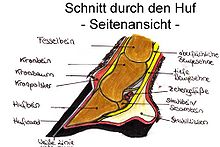Podotrochlosis
The navicular , also Hufrollennekrose , navicular disease or palmar hoof syndrome (PHS) is a horse disease . This disease of the horse is an inflammatory , degenerative change in the area of the hoof roll of the hoof of odd- toed ungulates , especially horses, which consists of navicular bone , flexor tendon and hoof roll bursa. The necrosis is seen in the navicular bone, which changes over time.
causes
Overloading of the hoof roller is generally assumed to be the cause of podotrochlosis. Since the problem is not observed in wild horses , it is assumed that the other type of stress on the hoof system leads to faster wear in riding horses. While the horse's musculoskeletal system is optimized for rapid forward movement as a flight animal , curved lines are often chosen when riding, which lead to greater stress on the joints . Excessive work on the front limb can also damage the hoof roller.
An abnormally shaped hoof can also lead to inflammation of the roll. Hooves that are too steep or too flat with narrow heels have a reduced damping effect and put a strain on the hoof roller. Insufficient care of the hoof can lead to circulatory disorders and thus to damage to the hoof roller.
Since the syndrome can also occur in young horses that are not yet ridden, it is now assumed that there is a predisposition, but heredity is not certain. Nutritional deficiencies in rearing can also play a role. Another theory suggests a connection with a pinched nerve on the seventh cervical vertebra , which innervates the arteries in the front legs and thus affects the blood flow in the hoof. None of the possible causes is certain and a combination of different factors may be possible.
Symptoms
Sometimes there is a stiff gait, especially on hard ground, with alternating relief of the forelegs by stretching out (relieving the hoof roller). In the case of unilateral podotrochlosis, accordingly only on one side, then possibly also associated with lameness . The horse often reacts to a wedge test that stresses the hoof roller area with increased lameness. X-ray recordings, preferably digital recordings here for reasons of image quality, of the navicular bone from behind show changes in the bone substance, in particular swellings on the canals running down in the navicular bone. In terms of differential diagnosis, the location of the degenerative process can be narrowed down further using scintigraphy and ultrasound in order to also include soft tissues.
treatment
According to one opinion, an interruption of work and paddock for six months, if the course is monitored to rule out further deterioration, can bring about a cure in the initial stage , possibly supported by anti-inflammatory agents ( cortisone injection as a shock therapy into the hoof roller, then non-steroidal anti-inflammatory drugs such as meclofenamic acid , Flunixin or phenylbutazone ) and a natural hoof cutout. The aim of measures in the later stages is rather to halt the progression of the necrosis and stop the inflammatory process; According to the prevailing opinion, healing in the sense of restoring lost substance is no longer possible. A special fitting with a damper, iron or, if necessary, damping synthetic horseshoes can alleviate the pain. The positive effect of blood circulation enhancing agents is not certain, although theoretically it should be helpful, at least for shod horses.
A neurectomy (nerve incision) of the palmar nerves ( nervi digitales palmares of the median nerve ) can make the horse pain-free, but will only lengthen the period of time until the podotrochlosis progresses. In addition, some horses tend to stumble as a result. In addition, careful care of the hoof is necessary, as the horse no longer feels pain there and diseases in the hoof can initially spread without symptoms.
New treatment approaches that have not yet been tested or that have been confirmed by studies are shock wave therapy; treatment with bisphosphonates ( bisphosphonate ) appears promising. Currently the only bisphosphonate approved for the treatment of hoof roll syndrome is clodronic acid (brand name Osphos ® ). The benefit of adding gallium nitrate with drinking water has rarely been studied. A reconstruction of the damaged synovia may be possible with glucosamine sulfate . If the new treatments prove themselves in the next few years, podotrochlosis could lose much of its horror. Leech treatment is recommended as an alternative method for treating podotrochlosis, but the therapeutic benefit has not yet been sufficiently proven.
